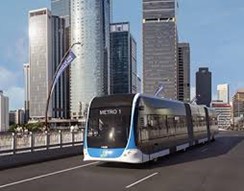The profligate ACT Government should read and heed how Brisbane is solving its public transport demands and it is not with outrageously expensive and outdated trams.
The Brisbane City Council has been planning its new all-electric bus metro system since 2016, with service to commence in 2024. Page 26 of the Brisbane Metro Business Case claims a positive economic case that “On a conservative basis, the cost benefit analysis results show a discounted benefit cost ratio (BCR) of 1.91. That is, for every $1 of total expenditure, Brisbane Metro is expected to return $1.91 of benefits to the local economy. The estimated risk-adjusted capital cost is $944 million” [May 2017].
 The first stage of Brisbane Metro is underway and will provide two new Brisbane Metro lines connecting 18 stations along dedicated busways between Eight Mile Plains and Roma Street, and Royal Brisbane and Women’s Hospital and The University of Queensland. All of Brisbane will benefit from a greater transport network, with easy links between Brisbane Metro, bus and train services.
The first stage of Brisbane Metro is underway and will provide two new Brisbane Metro lines connecting 18 stations along dedicated busways between Eight Mile Plains and Roma Street, and Royal Brisbane and Women’s Hospital and The University of Queensland. All of Brisbane will benefit from a greater transport network, with easy links between Brisbane Metro, bus and train services.
Benefits
- Reduce congestion bottlenecks in the city for a better-planned network
- Making it easier to travel with turn-up-and-go services and 24 hours on the weekend — no timetables needed
- All-electric vehicles with zero tailpipe emissions for a cleaner and greener Brisbane
- Creating 2600 jobs throughout design and construction
As part of Brisbane Metro, Brisbane City Council will introduce a new fleet of 60 all-electric, high-capacity Brisbane Metro vehicles. These will integrate seamlessly into busway operations and share the busway with existing bus services, as part of a better planned network.
They will be an Australian-first, using tried and tested European technology that will help future-proof Brisbane’s public transport network. Each vehicle will be 24.4 metres in length and 2.55 metres wide, with the capacity to carry 150 passengers in comfort and 170 passengers in event mode.
https://www.brisbane.qld.gov.au/traffic-and-transport/public-transport/brisbane-metro
The Business Case
NB: What follows is a comment on the business case only and not intended to detract from or criticise the project in any way.
The Business Case for Brisbane Metro is not a true business case as defined by some professional references. See the article ‘Value for Money Analysis’, under the Value/$$$ page, which defines what a business case should do.
In particular, the Case does not consider options for its transport network, such as suburban or light rail, but concentrates on how best to meet the travel demands of a bus network. It presumes dominating benefits of electric buses.
The Case claims a discounted benefit cost ratio (BCR) of 1.91 for $944 million (in 2017). However, the real cost will almost certainly be much higher.
Governments are experts at minimising the apparent cost of a project by the mistaken use (either to mislead or through incompetence) of what is generally referred to as discount cash flow (DCF) analysis.
The fundamental use and purpose of DCF is in the comparison of tendered options. However, even when there is no competing option to consider, the government misuses DCF to come up with minimal cost estimates, more palatable to the taxpaying public.
Although the Case does not mention the discount rate used, an assumed rate of 7.2% per annum (as assumed in the Canberra light rate Business Case) would mean a real cost of some $1.5 billion by 2024. At the bare minimum, the probable cost would be about $1.15 to $1.20 billion by 2024, assuming average contracted escalation indexes of 2 to 3% pa). The Case does not provide any details to justify the project cost claim.
M.R. Flint
Principal, Australian Logistics Study Centre
20 January 2022


